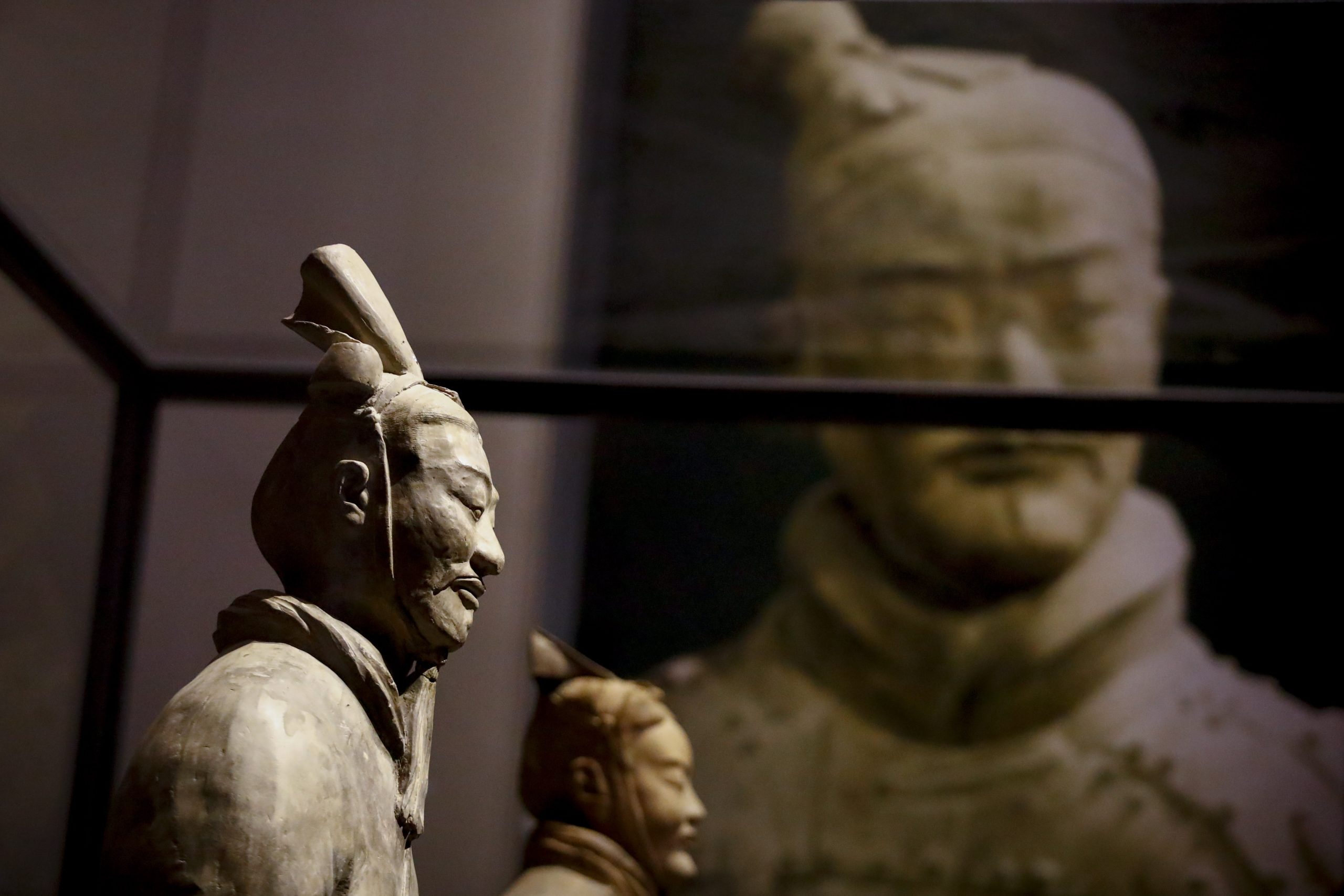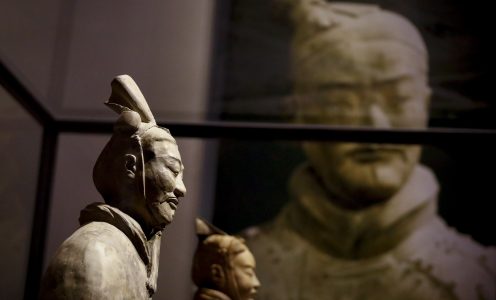Terracotta Warriors, also known as the Terracotta Army, stand as one of the most significant archaeological discoveries of the 20th century. These life-sized figures, unearthed in Xi’an, China, offer a glimpse into the rich history and cultural legacy of ancient China. The terracotta warriors were commissioned by Emperor Qin Shi Huang, the first Emperor of China, who reigned from 246 to 210 BCE. Their purpose was to protect the emperor in the afterlife, a testament to his power and the elaborate funerary practices of the time.
The Discovery
In March 1974, local farmers digging a well stumbled upon fragments of the terracotta figures. This accidental discovery led to extensive archaeological excavations, revealing an underground army that had lain buried for over two millennia. To date, more than 8,000 terracotta warriors, 130 chariots, and 670 horses have been unearthed, each with unique facial expressions and details, showcasing the advanced craftsmanship of the Qin Dynasty.
Historical Context
Emperor Qin Shi Huang is a pivotal figure in Chinese history. He is credited with unifying China and initiating numerous monumental projects, including the construction of the Great Wall and the Lingqu Canal. His reign, though short-lived, laid the foundations for the centralized bureaucratic state that would characterize Chinese governance for centuries. The creation of the Terracotta Warriors reflects his ambition and the belief in the afterlife, where such a formidable force would ensure his continued dominance.
Construction and Craftsmanship
The Terracotta Warriors were crafted with meticulous detail, each figure assembled from parts produced in workshops that likely employed thousands of laborers. The bodies were made using molds, but the heads, hands, and other features were hand-sculpted to ensure individuality. This assembly line technique allowed for both efficiency and uniqueness. The figures were originally painted in vibrant colors, although most of the pigments have faded over time due to exposure to air.
Significance and Symbolism
The Terracotta Warriors serve multiple symbolic purposes. They represent the might of Emperor Qin Shi Huang, the sophistication of Qin-era art and military practices, and the ancient Chinese belief in life after death. The terracotta warriors include a range of military ranks, from foot soldiers to generals, reflecting the hierarchical structure of Qin society. The presence of non-military figures, such as acrobats and musicians, suggests that the emperor’s court in the afterlife was meant to be as lively and multifaceted as it was in life.
The Mausoleum Complex
The terracotta warriors are part of a much larger mausoleum complex, which remains largely unexcavated. The central tomb, believed to house the emperor himself, is an immense, pyramid-shaped structure. According to historical texts, it is surrounded by a moat of mercury and filled with treasures, though modern testing has detected high levels of mercury, lending credibility to these accounts. Excavation of the central tomb is pending due to concerns about preservation and the technological limitations of current archaeological methods.
Preservation and Conservation
Since their discovery, the preservation of the Terracotta Warriors has been a major concern. Efforts include climate control within the excavation pits and the use of advanced chemical treatments to prevent further deterioration. Conservationists also work to restore the original colors and repair damage caused by the initial burial and later excavation processes.
Tourism and Cultural Impact
The Terracotta Warriors have become a global icon, drawing millions of visitors annually to Xi’an. They offer an invaluable educational resource, providing insights into ancient Chinese art, military history, and burial practices. The site is a UNESCO World Heritage Site, reflecting its global cultural significance. Additionally, traveling exhibitions of the terracotta warriors have been displayed in museums worldwide, further promoting their historical and cultural value.
The Creation and Symbolism of the Warriors
The Workshops
The production of the Terracotta Army was an immense undertaking, organized through a sophisticated system of workshops. Each workshop was responsible for different parts of the figures, such as heads, torsos, limbs, and armor. This division of labor allowed for both mass production and the individualization of each warrior. The workshops employed a variety of techniques, including modeling, sculpting, and painting, demonstrating the advanced technological capabilities of the Qin Dynasty.
The Faces of the Warriors
One of the most striking features of the Terracotta Warriors is the diversity of their facial expressions and features. Each terracotta warrior has a unique face, reflecting different ethnic backgrounds and personal characteristics. This individuality is believed to represent the various regions and peoples within the Qin Empire, emphasizing the emperor’s control over a vast and diverse territory.
The Armor and Weaponry
The terracotta warriors are depicted wearing detailed armor and carrying an array of weapons, including swords, spears, and crossbows. The level of detail in the armor and weaponry provides valuable information about the military technology and practices of the time. The weapons were made using advanced metallurgical techniques, such as chrome plating, which prevented rust and increased durability.
The Excavation and Its Challenges
Early Excavations
The initial excavations of the Terracotta Army site were conducted with great care, but they also faced significant challenges. The fragile nature of the figures, the potential for further discoveries, and the need for preservation all required careful planning and execution. Archaeologists had to develop new methods for excavating and preserving the figures to prevent damage.
Ongoing Discoveries
Excavations at the Terracotta Army site continue to this day, with new discoveries being made regularly. These ongoing excavations provide new insights into the construction, organization, and purpose of the army. Each new find adds to our understanding of the complex and the Qin Dynasty.
Preservation Techniques
Preservation of the Terracotta Warriors involves a combination of traditional and modern techniques. Archaeologists use advanced imaging and chemical analysis to study and preserve the figures. Efforts are also made to stabilize the site and protect it from environmental factors such as humidity and temperature changes.
The Cultural and Historical Significance
A Window into the Past
The Terracotta Warriors offer a unique window into the past, providing valuable information about the Qin Dynasty and its culture. They reveal the artistic and technological achievements of the time and offer insights into the political and social organization of the empire.
The Emperor’s Legacy
The creation of the Terracotta Army reflects Emperor Qin Shi Huang’s ambition and vision. It is a testament to his belief in the afterlife and his desire to maintain his power and influence even in death. The army also symbolizes the emperor’s control over his subjects and his ability to mobilize resources on an unprecedented scale.
Global Impact
The discovery of the Terracotta Warriors has had a significant impact on the global understanding of ancient China. It has increased interest in Chinese history and culture and has led to greater appreciation for the achievements of the Qin Dynasty. The site has become a major tourist attraction, drawing visitors from around the world and contributing to the local economy.
The Terracotta Warriors in Modern Culture
Exhibitions and Media
The Terracotta Warriors have been featured in numerous exhibitions and media, bringing their story to a global audience. Traveling exhibitions of the figures have been displayed in major museums worldwide, allowing people to experience the wonder of the Terracotta Army firsthand. They have also been the subject of documentaries, books, and films, further cementing their place in popular culture.
Educational Programs
Educational programs and resources related to the Terracotta Warriors are widely available, providing valuable learning opportunities for students and scholars. These programs often include interactive exhibits, workshops, and lectures, allowing participants to engage with the history and significance of the figures in a meaningful way.
Research and Scholarship
Research on the Terracotta Warriors continues to be a vibrant field of scholarship, with new studies and publications regularly emerging. Scholars from various disciplines, including archaeology, history, and art, contribute to a growing body of knowledge about the figures and their context. This ongoing research helps to deepen our understanding of the Terracotta Army and its place in Chinese history.
Conclusion
The Terracotta Warriors are a remarkable testament to the power and vision of Emperor Qin Shi Huang and the advanced capabilities of the Qin Dynasty. Their discovery has provided invaluable insights into ancient Chinese culture, art, and military practices. As a symbol of China’s rich heritage, the Terracotta Army continues to captivate and inspire people around the world. Through ongoing research, preservation efforts, and educational programs, the legacy of the Terracotta Warriors will continue to be celebrated and studied for generations to come.
By visiting the Terracotta Army site or engaging with its story through exhibitions and media, we can gain a deeper appreciation for this extraordinary archaeological wonder and the history it represents. The Terracotta Warriors not only reflect the grandeur of a past civilization but also serve as a bridge connecting us to the rich and diverse cultural heritage of China.


